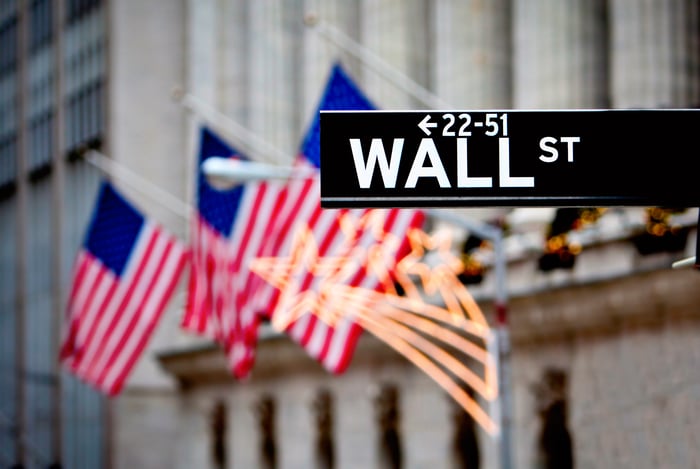For well over a century, the Dow Jones Industrial Average (^DJI 0.92%) has served as a barometer that gauges the health of the U.S. stock market.
When the Dow Jones was officially incepted on May 26, 1896, it was comprised of a dozen companies, most of which were tied to the industrial sector. Today, it contains an assortment of 30 historically profitable, time-tested, industry-leading businesses.
Over the last 128 years, this iconic index has undergone 52 meaningful changes, excluding components altering their name or existing Dow constituents merging. The most recent change had been Amazon entering the index and pharmacy chain Walgreens Boots Alliance getting the heave-ho in February -- that is, until today.
Before trading begins on Friday, Nov. 8, a new era will begin for the Dow Jones Industrial Average.

Image source: Getty Images.
Wall Street's ageless index gains added exposure to the AI revolution
The 53rd change to the components of the Dow Jones will see artificial intelligence (AI) leader Nvidia (NVDA 0.10%) enter the Dow and legacy semiconductor company Intel (INTC -1.33%) head for the exit.
Aside from being late to the AI party, Intel has the lowest share price within the Dow. Unlike the market cap-weighted S&P 500 and Nasdaq Composite, where larger companies exert more influence on these respective indexes, the Dow is a share price-weighted index. Market cap is irrelevant in the context of affecting the Dow's point value.
Significant losses tied to Intel's Foundry division, which it's building from the ground up, as well as central processing unit market share losses to Advanced Micro Devices, made Intel a virtual non-factor for this 128-year-old index.
Meanwhile, Nvidia's largest-ever stock split (10-for-1) in June paved the way for it to become one of the 30 components in the Dow. Without this split, Nvidia would be pushing close to $1,400 per share, which wouldn't have worked with the Dow's share price-weighted formula.
The addition of Nvidia gives the mature stock-focused Dow a new growth component, as well as positions the index to take advantage of the rise of AI. According to the analysts at PwC, the combination of productivity gains and consumption-side effects tied to the AI revolution can add $15.7 trillion to the global economy by 2030.
Nvidia's hardware is at the center of the hype surrounding artificial intelligence. Its H100 graphics processing unit (GPU) and next-generation Blackwell GPU are the brains behind the split-second decision-making needed to run generative AI solutions and build/train large language models. Over a three-year stretch, Nvidia's full-year sales are expected to climb from a reported $27 billion to an estimated $179 billion -- and AI accounts for pretty much the entirety of this projected increase.
Although demand for Nvidia's solutions remains robust, as does the company's pricing power for its hardware, the addition of this AI leader may expose Wall Street's widely followed stock index to an eventual bubble-bursting event.
For three decades, investors have consistently overestimated how long it would take for a game-changing technology to be adopted and/or gain widespread utility. In every instance, it's resulted in a new technology or innovation failing to live up to lofty expectations. Nothing suggests AI is going to avoid the fate of prior next-big-thing trends, which includes the advent of the internet. If the AI bubble were to burst, the Dow would be exposed to added downside, compared to if Intel were to remain in the index.

Image source: Getty Images.
A new materials sector component gains immediate relevance
On top of the flagship addition of Nvidia, S&P Dow Jones Indices -- the committee that votes on the stocks that enter and leave the Dow -- has chosen to boot materials science solutions company Dow Inc. (DOW 1.59%) and replace it with painting and coating giant Sherwin-Williams (SHW 0.94%).
The writing had been on the wall for some time that Dow Inc. would be shown the door. Following the 2017 merger between Dow Chemical and DuPont, the newly formed company (DowDuPont) had stated its intent to, eventually, split into three separate business. This split occurred in 2019, resulting in DuPont, Corteva, and Dow Inc. all going their separate ways. Dow Inc. remained in the Dow Jones Industrial Average, which technically gave DuPont (via the split) a continuous presence in the index since 1935. This officially comes to an end today.
Similar to Intel, Dow Inc.'s low share price made it a relative non-factor for the Dow Jones Industrial Average. Plus, with the loss of DuPont's and Corteva's operating divisions, it was no longer the diversified company it once was.
With Sherwin-Williams entering the Dow today, it immediately becomes one of the most-relevant components. Its $378 share price ranks sixth among the 30 constituents of this iconic index. Because of the wide gap in share price between Sherwin-Williams and Dow Inc., as well as Nvidia and Intel, S&P Dow Jones Indices will be adjusting the Divisor used to turn share price into Dow points.
Being cyclical is arguably the biggest investment draw for Sherwin-Williams. Even though downturns in the U.S. economy are normal and inevitable, they tend to be short-lived. Three-quarters of the 12 U.S. recessions since the end of World War II were resolved in less than 12 months. By comparison, most periods of growth extend for multiple years. This leads to growing consumer, commercial, an industrial demand for the company's products over time, as well as lifts its pricing power.
To add, Sherwin-Williams has done an excellent job of leaning on inorganic growth to expand. Though most of these acquisitions are of the bolt-on variety, management hasn't been afraid to grab a marquee name from time to time, just as Sherwin-Williams did when it acquired Valspar for $11.3 billion in an all-cash deal in 2017.
The Dow Jones Industrial Average can go years without changes being made. Today begins a new era for this iconic index.





